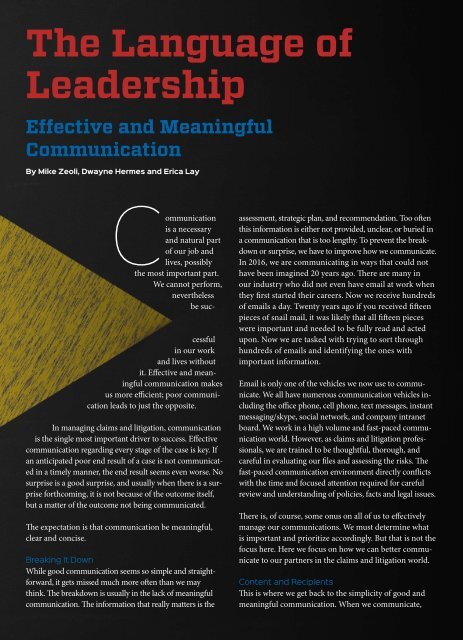LITIGATION MANAGEMENT
LMgmt317
LMgmt317
Create successful ePaper yourself
Turn your PDF publications into a flip-book with our unique Google optimized e-Paper software.
The Language of<br />
Leadership<br />
Effective and Meaningful<br />
Communication<br />
By Mike Zeoli, Dwayne Hermes and Erica Lay<br />
Communication<br />
is a necessary<br />
and natural part<br />
of our job and<br />
lives, possibly<br />
the most important part.<br />
We cannot perform,<br />
nevertheless<br />
be successful<br />
in our work<br />
and lives without<br />
it. Effective and meaningful<br />
communication makes<br />
us more effcient; poor communication<br />
leads to just the opposite.<br />
In managing claims and litigation, communication<br />
is the single most important driver to success. Effective<br />
communication regarding every stage of the case is key. If<br />
an anticipated poor end result of a case is not communicated<br />
in a timely manner, the end result seems even worse. No<br />
surprise is a good surprise, and usually when there is a surprise<br />
forthcoming, it is not because of the outcome itself,<br />
but a matter of the outcome not being communicated.<br />
The expectation is that communication be meaningful,<br />
clear and concise.<br />
Breaking It Down<br />
While good communication seems so simple and straightforward,<br />
it gets missed much more often than we may<br />
think. The breakdown is usually in the lack of meaningful<br />
communication. The information that really matters is the<br />
assessment, strategic plan, and recommendation. Too often<br />
this information is either not provided, unclear, or buried in<br />
a communication that is too lengthy. To prevent the breakdown<br />
or surprise, we have to improve how we communicate.<br />
In 2016, we are communicating in ways that could not<br />
have been imagined 20 years ago. There are many in<br />
our industry who did not even have email at work when<br />
they first started their careers. Now we receive hundreds<br />
of emails a day. Twenty years ago if you received fifteen<br />
pieces of snail mail, it was likely that all fifteen pieces<br />
were important and needed to be fully read and acted<br />
upon. Now we are tasked with trying to sort through<br />
hundreds of emails and identifying the ones with<br />
important information.<br />
Email is only one of the vehicles we now use to communicate.<br />
We all have numerous communication vehicles including<br />
the offce phone, cell phone, text messages, instant<br />
messaging/skype, social network, and company intranet<br />
board. We work in a high volume and fast-paced communication<br />
world. However, as claims and litigation professionals,<br />
we are trained to be thoughtful, thorough, and<br />
careful in evaluating our files and assessing the risks. The<br />
fast-paced communication environment directly conflicts<br />
with the time and focused attention required for careful<br />
review and understanding of policies, facts and legal issues.<br />
There is, of course, some onus on all of us to effectively<br />
manage our communications. We must determine what<br />
is important and prioritize accordingly. But that is not the<br />
focus here. Here we focus on how we can better communicate<br />
to our partners in the claims and litigation world.<br />
Content and Recipients<br />
This is where we get back to the simplicity of good and<br />
meaningful communication. When we communicate,<br />
Winter 2017 | <strong>LITIGATION</strong> <strong>MANAGEMENT</strong> | 21


